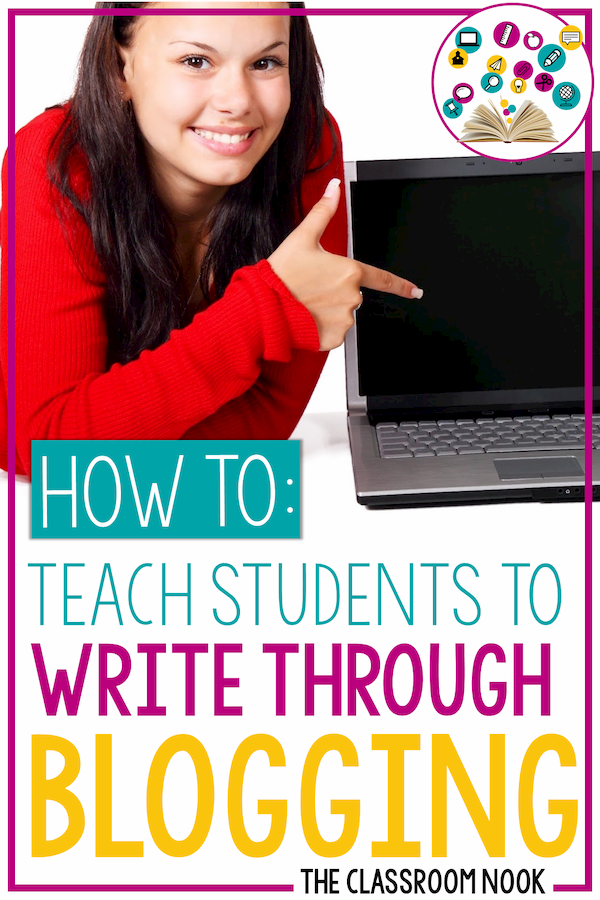Student Blogging {A New Kind of Journal Writing}

More and more, teachers are looking for ways to take traditional paper/pencil activities and make them digital. We've seen interactive notebooks go digital, the increased use of digital friendly resources, and other tasks take a digital turn.
You May Also Like to Read:
This is a trend that I don't believe is going away any time soon, so we might as well get on board, right?
So, what's next?
In today's post I'd like to share with you one more way that you can put your class-set of tablets, iPads, or chrome books to good use:
STUDENT BLOGGING.
Now - before you say "but I have no idea how to set up a blog!" Make sure you read this post all the way to the end where I share a step-by-step video tutorial for getting set up!
Student blogging is the perfect way to marry together daily or weekly journaling with technology. And there's an easy (and FREE) way to do it. If your students have a google account (also free), then they have access to blogger, a user-friendly blogging platform, and YOU have an interactive way for your students to communicate to you through writing without having to lug home 23 composition notebooks each weekend to read. What's better is that since you can access your blogger account from any digital device, student blogging could be done at school or home.
WHAT DO I NEED TO GET STARTED WITH STUDENT BLOGGING?
If you wanted to, you could start student blogging tomorrow. There's very little prep to get started and it's relatively simple to learn the platform.
Here's what you'll want to have set in place to get started:
1) Easy and regular access to a digital device such as a chrome book, tablet, or iPad, or computer
2) Internet access
3) Google accounts set up for each student (students will need a gmail email address)
WAYS TO USE STUDENT BLOGGING IN YOUR CLASSROOM:
As they say, "the possibilities are endless!" Truly! Anything that you have your students writing about on a regular basis can be turned into a blogging assignment. Here are a few of my ideas to get your started:
morning journal writing
blog about books students are reading
science "lab" reports
use blogging as a writing center for free write
classroom memory log (start this at the beginning of the year)
use at the end of the day as an "exit ticket" (give students a question to answer each day about something that they learned to journal about)
SETTING UP ROUTINES AND PROCEDURES FOR STUDENTS BLOGGING:
As with any new activity or task in your classroom, having solid routines and procedures in your classroom will be crucial for student blogging success. Consider developing the following routines and procedures if/when you decide to implement student blogging:
Where will the digital devices be held for student blogging?
When during the school day will blogging time be allowed/expected?
How are the devices to be stored in their holding place?
What behavioral expectations are there for retrieving and putting away the digital devices before/after student blogging?
What are the behavioral expectations DURING blogging time?
What are students allowed to blog about?
You may also want to create anchor charts/posters to display in your classroom as reminders for these procedures and routines.
You May Also Like to Read:
GETTING MY STUDENTS STARTED WITH BLOGGING:
Student blogging is NOT something that you will want to approach with the "hit the ground running" mentality. In fact, you will want to take your time and gradually release blogging responsibility to your students. Below you will find a sample start-up plan for introducing blogging to your students.
(Tip: Right click and save the image to your computer for reference later)
*Note that each lesson may take more than one day to complete and master.
You may find it helpful to create a "cheat sheet" for you students to reference for how to complete different tasks and use certain features of the platform, such as how to add a picture or link. In addition, you may want to give students a checklist of steps that you'd like them to complete from start to finish each time they writing a new post (ex. create a title, include at least 2 images...etc).
You May Also Like to Read:
TIPS AND BEST PRACTICES FOR USING TECHNOLOGY IN THE CLASSROOM
TRAINING VIDEO:
If you're thinking: "Sure, this looks nice, but I have no idea where to begin when it comes to blogging." Friend, I've gotcha covered. I put together a short training video below to help walk you through some of the technical details about student blogging through the blogger platform.

